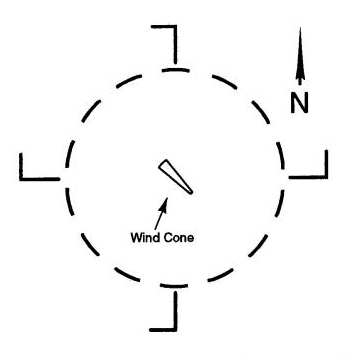Wind Socks
A wind sock indicates wind direction and speed as the wind blows through the larger opening through to its smaller end. If the wind sock is hanging limp, calm wind is indicated. The more straight out the wind sock is extended, the higher the indicated wind speed. The size of wind socks and the relative size of the large and small openings varies. This means one wind sock might fly straight out with 15 knots of wind, while another might have a bend half way up its length with 15 knots.
The large opening of the wind sock faces the direction from which the wind blows.
Landing Tee
At some airports, a landing tee is installed, which indicates wind direction but not speed. The wind tee swings with the wind so that it is readable as the letter "T" when you are facing into the wind.
At some airports, the landing tee might be manually set by persons at the airport. As a result, a landing tee may not always accurately reflect wind direction.
Tetrahedron
A tetrahedron is a wind direction indicator that points the direction from which the wind is blowing. Tetrahedrons provide no indication of wind speed.
At some airports, the tetrahedron might be set manually. Be cautioned that the tetrahedron might not accurately reflect wind direction.
Segmented Circle
Some airports utilize a segmented circle, which provides wind and traffic pattern procedures information to pilots. The segmented circle consists of a landing direction indicator or wind direction indicator, such as a tetrahedron or wind sock, surrounded by traffic pattern indicators.
These traffic pattern indicators visually depict the base and final legs of the traffic pattern, as they align with the appropriate runway when viewed from above.
As a pilot flies over this segmented circle, it can be seen that the traffic pattern for the north-south runway is meant to remain on the west side of the airport. The traffic patterns for the east-west runway are to remain north of the airport.
